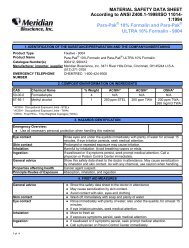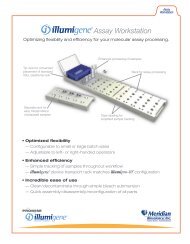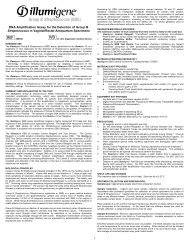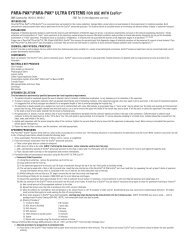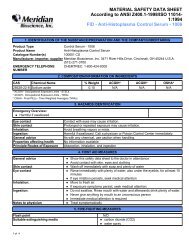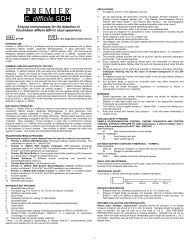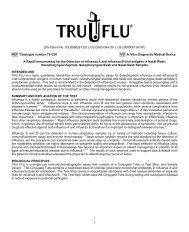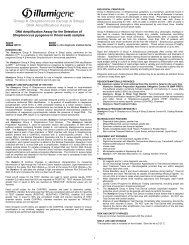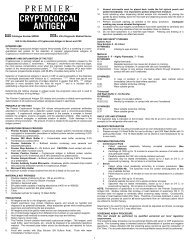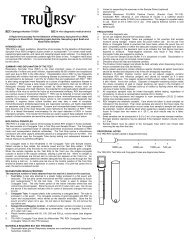LAMP Process - Meridian Bioscience, Inc.
LAMP Process - Meridian Bioscience, Inc.
LAMP Process - Meridian Bioscience, Inc.
You also want an ePaper? Increase the reach of your titles
YUMPU automatically turns print PDFs into web optimized ePapers that Google loves.
<strong>LAMP</strong> <strong>Process</strong><br />
<strong>LAMP</strong> <strong>Process</strong><br />
Target DNA<br />
1. Solution temperature at 60º–65º C<br />
2. Forward Initiating Primer (FIP) anneals to<br />
Target Sequence<br />
3. DNA Polymerase initiates synthesis that displaces<br />
single strand template DNA<br />
4. Through polymerase activity, a strand complementary<br />
to the DNA template is formed<br />
5. The F3 Primer anneals to the F3c Region<br />
6. DNA Polymerase initiates synthesis and the FIP-linked<br />
complementary strand is replaced<br />
7. This strand forms a “stem loop” at the 5’ end due to<br />
complementary F1 and F1c regions<br />
8. The BIP anneals to the 3’ end of the “stem loop” strand<br />
9. The B3 Primer anneals to the B3c target<br />
10. From the 3’ end, polymerase synthesizes a<br />
complementary DNA strand<br />
11. DNA reverts from a Loop structure to a linear structure<br />
12. The BIP linked complementary strand is displaced as<br />
a single strand<br />
13. This strand forms stem-loops at either end due to the<br />
activity of the dual complementary primers<br />
14. This is the starting structure for <strong>LAMP</strong> Cycling<br />
(Continued on next page)
<strong>LAMP</strong> <strong>Process</strong><br />
Molecular Diagnostic System<br />
<strong>LAMP</strong> <strong>Process</strong> (cont.)<br />
15. <strong>LAMP</strong> Cycling. A dumbbell-like DNA structure is quickly<br />
converted into a stem-loop DNA by self-primed DNA synthesis.<br />
FIP anneals to the single stranded region in the stem-loop DNA<br />
and primes strand displacement DNA synthesis, releasing the<br />
previously synthesized strand. This released single strand forms<br />
a stem-loop structure at the 3’ end because of complementary<br />
B1c and B1 regions.<br />
Then, starting from the 3’ end of the B1 region, DNA synthesis<br />
starts using self-structure as a template, and releases<br />
FIP-linked complementary strand (STEP 2).<br />
The released single strand then forms a dumbbell-like structure<br />
as both ends have complementary F1–F1c and B1c–B1<br />
regions, respectively (STEP 4).<br />
This structure is the ‘turn over’ structure of the structure formed in<br />
STEP 1. Similar to the STEPS 1 THROUGH 4, structure in STEP 4<br />
leads to self-primed DNA synthesis starting from the 3’ end of the<br />
B1 region.<br />
Furthermore, BIP anneals to the B2c region and primes strand<br />
displacement DNA synthesis, releasing the B1-primed DNA strand.<br />
Accordingly, similar structures to STEPS 2 AND 3 as well as the<br />
same structure as STEP 1 are produced. With the structure<br />
produced in STEP 3, the BIP anneals to the single strand B2c<br />
region, and DNA synthesis continues by displacing double stranded<br />
DNA sequence. As a result of this process, various sized structures<br />
consisting of alternately inverted repeats of the target sequence on<br />
the same strand are formed.<br />
For more information, contact an illumigene specialist at 1-888-763-6769 or visit us on the web at www.meridianbioscience.com.<br />
ILLUMI_<strong>LAMP</strong>_INSRT REV. 12/11<br />
© 2010 <strong>Meridian</strong> <strong>Bioscience</strong>, <strong>Inc</strong>. All rights reserved.




